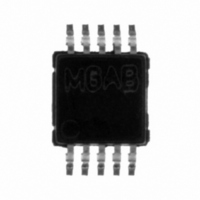LM4895MM/NOPB National Semiconductor, LM4895MM/NOPB Datasheet - Page 12

LM4895MM/NOPB
Manufacturer Part Number
LM4895MM/NOPB
Description
IC AMP AUDIO PWR 1.4W AB 10MSOP
Manufacturer
National Semiconductor
Series
Boomer®r
Type
Class ABr
Datasheet
1.LM4895LD.pdf
(15 pages)
Specifications of LM4895MM/NOPB
Output Type
1-Channel (Mono)
Max Output Power X Channels @ Load
1.4W x 1 @ 4 Ohm
Voltage - Supply
2.2 V ~ 5.5 V
Features
Depop, Differential Inputs, Shutdown, Thermal Protection
Mounting Type
Surface Mount
Package / Case
10-MSOP, Micro10™, 10-uMAX, 10-uSOP
Operational Class
Class-AB
Audio Amplifier Output Configuration
1-Channel Mono
Output Power (typ)
1x1@8OhmW
Audio Amplifier Function
Speaker
Total Harmonic Distortion
0.1@8Ohm@400mW%
Single Supply Voltage (typ)
3/5V
Dual Supply Voltage (typ)
Not RequiredV
Power Supply Requirement
Single
Rail/rail I/o Type
No
Power Supply Rejection Ratio
84dB
Single Supply Voltage (min)
2.2V
Single Supply Voltage (max)
5.5V
Dual Supply Voltage (min)
Not RequiredV
Dual Supply Voltage (max)
Not RequiredV
Operating Temp Range
-40C to 85C
Operating Temperature Classification
Industrial
Mounting
Surface Mount
Pin Count
10
Package Type
MSOP
Lead Free Status / RoHS Status
Lead free / RoHS Compliant
Other names
LM4895MM
LM4895MM
LM4895MMTR
LM4895MM
LM4895MMTR
www.national.com
Application Information
However, a direct consequence of the increased power de-
livered to the load by a bridge amplifier is an increase in
internal power dissipation versus a single-ended amplifier
operating at the same conditions.
Since the LM4895 has bridged outputs, the maximum inter-
nal power dissipation is 4 times that of a single-ended am-
plifier. Even with this substantial increase in power dissipa-
tion, the LM4895 does not require additional heatsinking
under most operating conditions and output loading. From
Equation 3, assuming a 5V power supply and an 8Ω load,
the maximum power dissipation point is 625mW. The maxi-
mum power dissipation point obtained from Equation 3 must
not be greater than the power dissipation results from Equa-
tion 4:
The LM4895’s θ
Depending on the ambient temperature, T
surroundings, Equation 4 can be used to find the maximum
internal power dissipation supported by the IC packaging. If
the result of Equation 3 is greater than that of Equation 4,
then either the supply voltage must be decreased, the load
impedance increased, the ambient temperature reduced, or
the θ
traces near the output, V
lower the θ
heatsinking allowing higher power dissipation. For the typical
application of a 5V power supply, with an 8Ω load, the
maximum ambient temperature possible without violating the
maximum junction temperature is approximately 30˚C pro-
vided that device operation is around the maximum power
dissipation point. Recall that internal power dissipation is a
function of output power. If typical operation is not around the
maximum power dissipation point, the LM4895 can operate
at higher ambient temperatures. Refer to the Typical Per-
formance Characteristics curves for power dissipation in-
formation.
POWER SUPPLY BYPASSING
As with any power amplifier, proper supply bypassing is
critical for low noise performance and high power supply
rejection ratio (PSRR). The capacitor location on both the
JA
reduced with heatsinking. In many cases, larger
P
JA
DMAX
. The larger areas of copper provide a form of
P
= 4*(V
JA
DMAX
in an MUA10A package is 190˚C/W.
DD
= (T
DD
)
2
, and GND pins can be used to
/(2π
JMAX
2
R
- T
L
) Bridge Mode
A
)/θ
JA
(Continued)
A
, of the system
(2)
(3)
12
bypass and power supply pins should be as close to the
device as possible. A larger half-supply bypass capacitor
improves PSRR because it increases half-supply stability.
Typical applications employ a 5V regulator with 10µF and
0.1µF bypass capacitors that increase supply stability. This,
however, does not eliminate the need for bypassing the
supply nodes of the LM4895. Although the LM4895 will
operate without the bypass capacitor C
may decrease. A 1µF capacitor is recommended for C
value maximizes PSRR performance. Lesser values may be
used, but PSRR decreases at frequencies below 1kHz. The
issue of C
and click and pop performance.
SHUTDOWN FUNCTION
In order to reduce power consumption while not in use, the
LM4895 contains shutdown circuitry that is used to turn off
the amplifier’s bias circuitry. In addition, the LM4895 con-
tains a Shutdown Mode pin, allowing the designer to desig-
nate whether the part will be driven into shutdown with a high
level logic signal or a low level logic signal. This allows the
designer maximum flexibility in device use, as the Shutdown
Mode pin may simply be tied permanently to either V
GND to set the LM4895 as either a ’shutdown-high’ device or
a ’shutdown-low’ device, respectively. The device may then
be placed into shutdown mode by toggling the Shutdown
Select pin to the same state as the Shutdown Mode pin. For
simplicity’s sake, this is called ’shutdown same’, as the
LM4895 enters shutdown mode whenever the two pins are
in the same logic state. The trigger point for either shutdown
high or shutdown low is shown as a typical value in the
Supply Current vs Shutdown Voltage graphs in the Typical
Performance Characteristics section. It is best to switch
between ground and supply for maximum performance.
While the device may be disabled with shutdown voltages in
between ground and supply, the idle current may be greater
than the typical value of 0.1µA. In either case, the shutdown
pin should be tied to a definite voltage to avoid unwanted
state changes.
In many applications, a microcontroller or microprocessor
output is used to control the shutdown circuitry, which pro-
vides a quick, smooth transition to shutdown. Another solu-
tion is to use a single-throw switch in conjunction with an
external pull-up resistor (or pull-down, depending on shut-
down high or low application). This scheme guarantees that
the shutdown pin will not float, thus preventing unwanted
state changes.
B
selection is thus dependant upon desired PSRR
B
, although the PSRR
B
. This
DD
or





